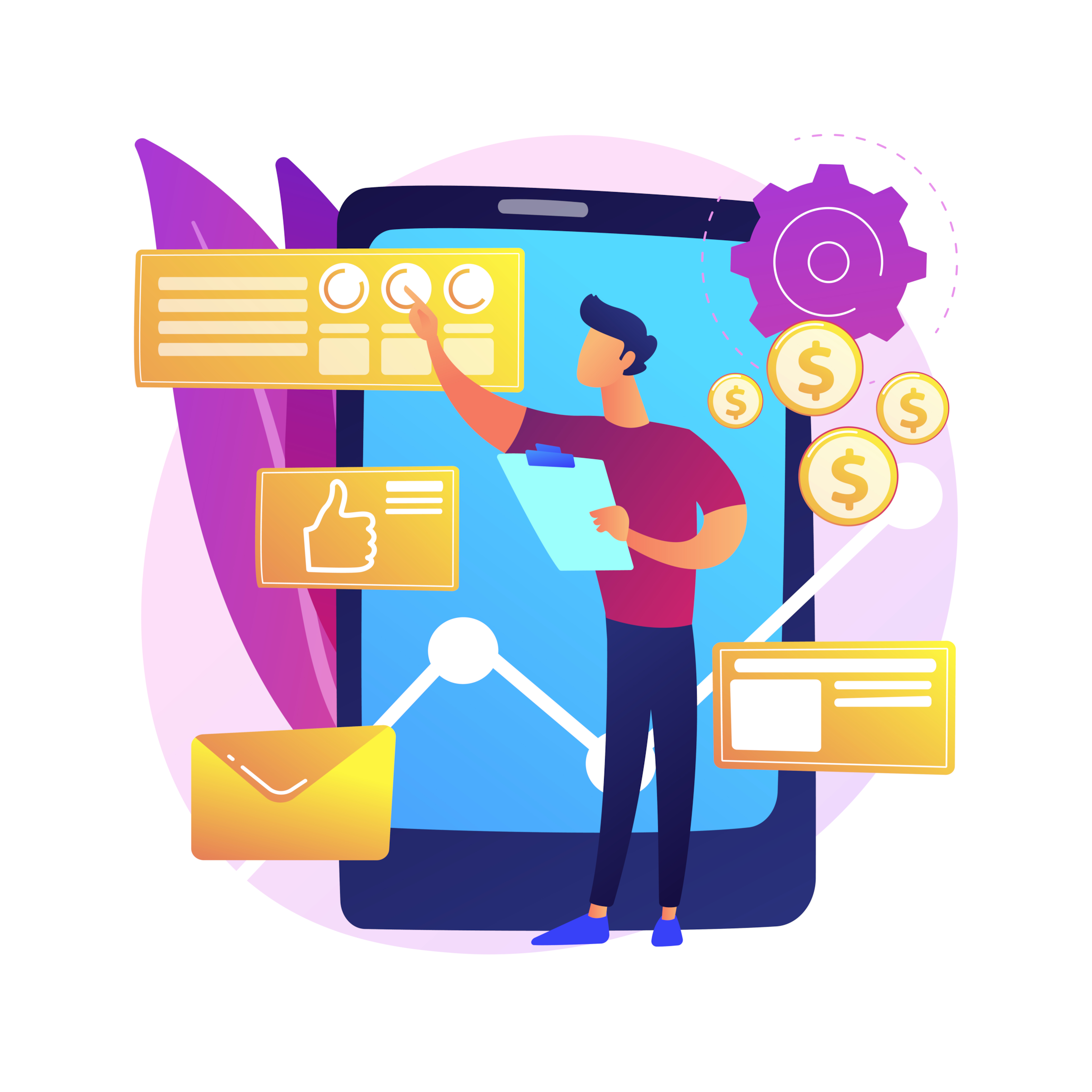We’ll increase conversions by
20-100+%
on your website.
Get a FREE Audit today
See how we can help your business increase conversion rates
Mobile Conversion Optimization – Average Bounce Rate

Bounce rate is a crucial metric in mobile conversion optimization, reflecting the number of visitors who swiftly depart a website after a single page view.
This rate, which varies depending on the niche and website genre, is generally perceived as an emblem of unsatisfactory user experience or lackluster content.
Hence, grasping and enhancing mobile bounce rates is imperative for companies aspiring to generate conversions and engagement through their mobile websites. This is where our blog on mobile conversion optimization comes in – by evaluating and optimizing their mobile bounce rates, businesses can foster a more gratifying user experience, escalate engagement, and, as a result, augment their mobile conversion rates.
What is Bounce Rate?
Bounce rate, a central metric in mobile conversion optimization, pertains to the fraction of website visitors who leave a website immediately after viewing only one page. Essentially, it quantifies the number of visitors who swiftly “bounce” away from the website after being directed to a page.
This metric is critical for companies as a higher bounce rate may signal a subpar user experience (UX) or a disconnect between the content on the page and the user’s expectations. By comprehending and optimizing the bounce rate, businesses can raise the probability of retaining visitors and augmenting conversions on their mobile website.
Bounce Rate in Mobile Conversion Optimization
Bounce rate is a critical metric in mobile conversion optimization as it measures the percentage of visitors who leave a website after visiting only one page.
A high bounce rate indicates that the website is not effectively engaging visitors and retaining their interest. In order to optimize for conversion, it’s important to understand why visitors are leaving the site and make changes to improve their experience.
Factors that contribute to a high bounce rate can include slow load times, a confusing or difficult-to-use interface, irrelevant content, or a lack of clear calls to action. By reducing the bounce rate, businesses can improve the chances of converting visitors into customers and drive more sales or web traffic through their mobile site.
Average Bounce Rates for Mobile Websites
The average bounce rate of mobile websites, a crucial metric in the field of conversion optimization, is subject to frequent fluctuations contingent on various elements, including the industry, the type of content, and the design of the website.
A bounce rate ranging between 26% and 40% is typically considered satisfactory, while rates surpassing 50% are viewed as problematic.
E-commerce sites, characterized by intense competition and the requirement for a smooth shopping experience, often display a higher average bounce rate, fluctuating between 40% and 60%. Conversely, content-driven sites, such as blogs, tend to exhibit a lower average bounce rate, averaging between 30% and 50%.
It’s vital to keep in mind that there’s no universal “ideal” bounce rate and that the optimal rate for each website will differ based on its individual goals and target audience.
By closely monitoring and analyzing their bounce rate, businesses can make astute decisions about optimizing their mobile website for enhanced user engagement and conversion.
1.) Factors that Affect Mobile Bounce Rates

Slow Loading Speeds
The pernicious influence of slow loading speed on mobile bounce rates cannot be overstated. Visitors are prone to exit a website if it takes too long to load, particularly on mobile devices where time is often a scarce commodity.
The slow loading speed can stem from various sources, including oversized images, subpar website design, and sluggish servers.
Furthermore, slow loading speed can also harm search engine optimization (SEO), as search engines like Google may administer penalties to sites that load at a snail’s pace. To alleviate the effects of slow loading speed on bounce rates, it’s imperative for businesses to continuously evaluate and enhance their website’s speed.
This may encompass compressing images, streamlining the design, and utilizing faster hosting services. By hastening the loading time of their mobile site, businesses can better the user experience, reduce bounce rates, and increase conversions.
Poor User Experience (UX)

The devastating impact of poor user experience (UX) on mobile bounce rates is beyond dispute. A bewildering or difficult-to-use interface, irrelevant content, or the absence of clear calls to action can all contribute to a negative user experience, causing visitors to swiftly depart a website.
Moreover, mobile websites with poor UX may also pose difficulties in navigation, leading to a high bounce rate as visitors strive to locate the information they seek.
To enhance the UX of a mobile website, it’s vital for businesses to assess elements such as the layout, navigation, and content of the site, and to consistently test and gather feedback from users.
By delivering a seamless and effortless experience, e-commerce sites or businesses can escalate engagement, lower bounce rates, and boost conversions on their mobile site.
Non-responsive Landing Page Design
Non-responsive design is a significant factor that can negatively impact mobile bounce rates. A non-responsive design means that a website is not optimized for viewing on mobile devices, and as a result, visitors may experience issues such as small text, distorted images, and a lack of clear calls to action.
This can lead to a frustrating user experience and cause visitors to quickly abandon the site.
To avoid the negative impact of non-responsive design on bounce rates, it’s important for businesses to ensure that their mobile website is optimized for viewing on various devices and screen sizes.
This can be achieved through the use of responsive design techniques, such as flexible grids and images, and the use of media queries.
By providing a seamless and optimized experience on all devices, businesses can reduce bounce rates and increase conversions on their mobile site.
How Content is Relevant to User Intent
The relevance of content to user intent is a crucial factor that affects mobile bounce rates. Visitors are more likely to remain on a website if the content is relevant to their needs and interests.
Conversely, if the content is irrelevant or poorly targeted, visitors are more likely to quickly abandon the site.
This can be especially true on mobile devices, where users are often looking for specific information or a solution to a problem in a timely manner.
To ensure that the content is relevant to user intent, businesses should perform keyword research and analyze user behavior to understand what their target audience is searching for.
They should also regularly review and update their content to ensure that it remains relevant and up-to-date. By providing relevant and targeted content, businesses can improve engagement, reduce bounce rates, and increase conversions on their mobile site.
2.) The Impact of High Bounce Rates on Mobile Conversion Rates

Decreased Engagement and Interest
High bounce rates on mobile devices can have a significant impact on conversion rates as they indicate decreased engagement and interest from users.
When a user lands on a mobile website and quickly leaves, it can be an indication that the website did not meet their expectations or was not optimized for mobile devices.
This can lead to a lower rate of conversions as users are not given the opportunity to interact with the website and engage with its content.
To mitigate the impact of high bounce rates, it is important for businesses to prioritize mobile optimization and provide a seamless user experience that meets the needs of their mobile audience.
This can include improving page load speeds, simplifying navigation, and presenting relevant and compelling content.
Lost Opportunities for Conversion
High bounce rates on mobile devices can result in lost opportunities for conversion and interest from users.
When a user quickly leaves a website after arriving on it, they may not be given the chance to explore the products or services offered and decide to make a purchase. search rankings
This can lead to a lower rate of conversions and result in missed business opportunities. In addition, high bounce rates can also signal a lack of user engagement and interest, which can impact the overall perception of the business and damage its reputation.
To prevent this, it is important for businesses to prioritize mobile optimization and ensure that their mobile websites provide a user-friendly experience that encourages engagement and drives conversions.
This can involve implementing best practices for mobile design, such as responsive design and mobile-specific content, as well as regularly monitoring and analyzing bounce rates to identify areas for improvement.
Negative Impact on Search Engine Rankings
The impact of high bounce rates on mobile conversion rates can also have a negative impact on search engine rankings.
Search engines use various metrics to determine the quality and relevance of a website, including the amount of time users spend on the site.
High bounce rates can indicate that users are not finding the content on the site valuable or relevant, which can result in a lower search engine ranking.
This, in turn, can make it more difficult for the website to be discovered by potential customers and negatively impact the business’s online visibility.
To mitigate this, businesses should strive to reduce their bounce rates by providing a seamless and engaging mobile experience that keeps users engaged and encourages them to explore the site.
This can involve regularly auditing the site for technical and design issues, conducting user testing to understand the needs and preferences of their target audience, and using data and analytics to continuously improve the user experience. blog post
3.)Strategies to Improve Mobile Bounce Rates

Optimise for Speed and User Experience (UX)
To improve mobile bounce rates, businesses should focus on optimizing for speed and user experience (UX).
A slow-loading mobile website can be frustrating for users and increase bounce rates, while a user-friendly and engaging website can keep users engaged and reduce bounce rates.
One strategy to optimize for speed is to reduce the size of images and other media elements on the site, as well as minimize the use of heavy coding and scripts. Improving page load times can also be achieved through the use of a fast and reliable hosting service.
To optimize for UX, businesses can simplify navigation, provide clear and concise information, and use responsive design to ensure the site is easy to use on a range of mobile devices.
Conducting user testing and regularly monitoring and analyzing metrics can also provide valuable insights into how to improve the user experience and reduce bounce rates.
Implement Responsive Design
Implementing responsive design is one of the key strategies to improve mobile bounce rates. Responsive design ensures that the website adjusts to the screen size and resolution of the device being used, providing a seamless user experience on desktop computers, laptops, and mobile devices.
By adapting to different screen sizes, the responsive design minimizes the need for users to zoom in or scroll horizontally to view content, reducing the likelihood of them leaving the site.
Furthermore, using a responsive design approach can also improve the website’s search engine rankings as it can help provide a better user experience for mobile users, a factor that search engines take into account.
To ensure that responsive design is implemented effectively, businesses should regularly test their website on various devices and make necessary adjustments to improve the user experience and reduce bounce rates.
Conduct A/B Testing

Conducting A/B testing is another strategy that can help businesses improve their mobile bounce rates.
A/B testing involves creating two versions of a page and testing which one performs better. This can help businesses understand what changes to the user experience can have a positive impact on reducing bounce rates.
For example, businesses can test different headlines, images, call-to-action buttons, or page layouts to determine which version of the page is most effective at keeping users engaged and reducing bounce rates.
The results of the A/B test can then be used to make informed decisions about how to improve the user experience and reduce bounce rates on a larger scale.
Additionally, regularly conducting A/B tests can help businesses stay up-to-date with the latest user experience best practices and make ongoing improvements to their mobile website.
Utilise Behavioral Analytics and Heatmap Tools
Utilizing behavioral analytics and heatmap tools is another strategy that can help businesses improve their mobile bounce rates.
Behavioral analytics provide valuable insights into how users are interacting with the website, including the pages they visit, how long they spend on the site, and where they click.
Heatmap tools provide a visual representation of these interactions, allowing businesses to see exactly where users are clicking and what areas of the page are most engaging.
This information can then be used to identify areas for improvement and make changes to the user experience that can reduce bounce rates.
For example, businesses may use the insights gained from heatmaps to optimize their call-to-action buttons or improve the placement of images and other elements on the page.
Integrating behavioral analytics and heatmap tools into their mobile optimization strategy can help businesses gain a deeper understanding of their users and make informed decisions about how to reduce bounce rates and improve conversions.
Personalization

Personalization, an effective technique utilized to curate content and user experiences, holds immense potential to considerably influence mobile conversion optimization bounce rates.
Its salience emerges from its ability to aid businesses in presenting a range of content and offers that are strikingly relevant to the end user.
To achieve personalization, data, and analytics are leveraged to comprehend user behavior, predilections, and requisites, and consequently, hone the user experience to better suit the end user.
An illustration of personalization could encompass an array of actions such as presenting content or offers to users based on their geolocation, browsing history, or previous purchases.
By enhancing the user experience through personalization, businesses can ameliorate the bounce rate, besides augmenting user engagement and conversion rates.
Mobile-First Design
Mobile-first design, an innovative design approach, emphasizes prioritizing mobile devices over desktops while devising websites or applications.
This quintessential approach acknowledges the growing ubiquity of mobile devices in our daily routine, besides stressing the importance of delivering mobile-optimized experiences.
Mobile-first design constitutes a viable solution to alleviate bounce rates by crafting websites optimized for mobile devices petite screens and touch-based navigation.
Furthermore, this technique can facilitate the creation of websites that are replete with fast loading times, trimmed content, and unambiguous calls to action.
Mobile-first design adoption can pave the way for businesses to create mobile-optimized websites that foster user engagement and inflate conversions.
Mobile SEO

Mobile search engine optimization (SEO), a critical stratagem for businesses seeking to ameliorate mobile bounce rates, has garnered unprecedented importance in recent times.
With a majority of searches occurring on mobile devices, optimizing websites for mobile search has become indispensable.
This necessitates a robust approach encompassing optimization for mobile keywords, crafting mobile-friendly content, and guaranteeing easy accessibility and navigability on mobile devices.
Moreover, businesses ought to make certain their website is listed in local directories, besides ensuring that their Google My Business listing remains up to date.
By heightening their mobile SEO, businesses can amplify their visibility in mobile search results, optimize the user experience, and ultimately truncate mobile bounce rates.
Social Media Integration
Incorporating social media into a mobile website is a cutting-edge stratagem that businesses can adopt to mitigate mobile bounce rates.
In this digital era, social media platforms are the go-to place for mobile users, and embedding social media buttons into a mobile website can furnish users with an uncomplicated means to share and interact with content.
Furthermore, businesses can tap into social media to channel traffic to their mobile website through tailored advertisements and engaging social media content.
By fusing social media into their mobile optimization strategy, businesses can embellish the user experience and curtail mobile bounce rates.
Conclusion

Recap of Importance of Mobile Bounce Rates
Mobile bounce rates are an important metric for businesses to track and understand as they provide insights into the effectiveness of their mobile website.
High mobile bounce rates can indicate that the website is not providing a good user experience or that the content is not relevant to the user, resulting in lost opportunities for conversion and engagement.
On the other hand, low mobile bounce rates can indicate a well-optimized mobile website that is able to keep users engaged and improve conversions.
To achieve low mobile bounce rates, businesses should focus on strategies such as optimizing for speed and user experience, implementing responsive design, conducting A/B testing, and utilizing behavioral analytics and heatmap tools.
By understanding and improving their mobile bounce rates, businesses can improve the user experience and increase conversions, ultimately contributing to their success.
Emphasis on the Need for Continuous Optimization and Improvement

The need for continuous optimization and improvement of mobile websites cannot be emphasized enough.
With the increasing importance of mobile devices in our daily lives and the rapid advancements in technology, the expectations of mobile users continue to evolve.
As such, businesses must stay ahead of the curve by continually optimizing their mobile websites to meet the changing needs of their users.
This requires a data-driven approach, using tools such as behavioral analytics and heatmaps to identify areas for improvement and conducting regular A/B testing to determine the most effective changes to make.
Furthermore, businesses should also keep up with the latest design and user experience best practices to ensure that their mobile website is providing the best possible experience for their users.
By continuously optimizing and improving their mobile website, businesses can stay ahead of the competition, improve their mobile conversion rates, and ultimately achieve success.
Key Takeaways on the Role of Mobile Bounce Rates in Mobile Conversion Optimization

In conclusion, mobile bounce rates play a critical role in the optimization of mobile conversion rates.
A high mobile bounce rate can indicate that the website is not providing a good user experience or that the content is not relevant to the user, leading to lost opportunities for conversion and engagement.
On the other hand, a low mobile bounce rate can indicate a well-optimized mobile website that is able to keep users engaged and improve conversions.
By understanding and improving their mobile bounce rates, businesses can improve the user experience, increase conversions, and ultimately achieve success. The need for continuous optimization and improvement cannot be overstated, as the expectations of mobile users continue to evolve.
To stay ahead of the curve, businesses must adopt a data-driven approach, using tools such as behavioral analytics and heatmaps, conducting regular A/B testing, and staying up-to-date with the latest design and user experience best practices.
By taking a proactive approach to optimizing their mobile website, businesses can ensure they are providing the best possible experience for their users and achieving their desired mobile conversion rates.








